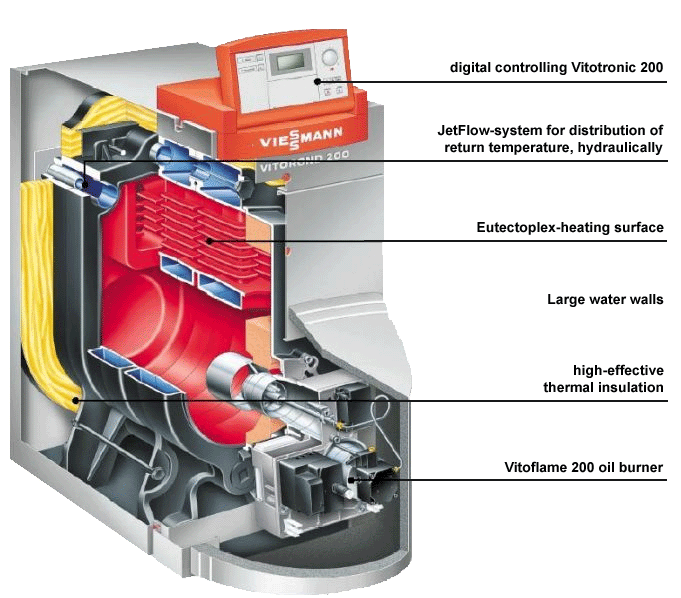
Heating systems
Heating systems help to ensure the thermal comfort of the inhabitants of buildings by meeting the heat demand created by heat transmission and ventilation losses.
Heating system consist of several components: The heat generator transforms the energy of the energy source into heat. The boiler delivers the available heat to a heat source like water or air. Heat energy and heat power are made available to the building through a distribution system. Radiators, convectors, floor heating, ceiling or wall elements are installed in every room as heat exchanger. The supply temperature of the boiler is normally controlled in relation to the outdoor temperature, while the indoor temperature is controlled by thermostats. Depending on the system, more components like thermal storage or solar collectors can be added. Some parts can even be dropped when using e.g. off-peak electricity heaters, which do not need a distribution system and take over the function of the complete system for the respective room.
Heating systems differ in their distribution system. In centralised systems the heat generator delivers the total heat for the building. This heat has to be transported by a distribution system to the individual rooms. Decentralised systems consist of several heat generators, which provide heat for each room or apartment separately. In this case, it is necessary to distribute the fuel or the energy source to the single heating locations.
Heating systems differ also in their source of energy. Table 1 contains a list which shows the percentage distribution of the sources of energy (in Germany) and their specific calorific values.
|
|||||||||||||||||||||
|
Table 1: Prevailing energy in % of inhabited units [3] and calorific value [2] of different fuels. |
Spit and brown coal
Today, pit and brown coal in their different forms (coke, briquettes) are not longer important because the corresponding systems are very uncomfortable and labour intensive and can be poorly controlled.
Electricity
One can still find many night storage heatings in old buildings. This heating system transforms electricity into heat with favourable rates at times where the utilisation of the mains is low. Then the heat is stored in ceramic-stones or in water and is given through ventilation into a room when needed. In the past, an advantage of night storage heating has been the low installation expenditure for replacement of single stoves because it was not necessary to install additional conduits for the heat distribution of a central hot-water system. Today, one can get under floor storage heating, too. The installation expenditure is quite high and therefore preferably used in new buildings. From the ecological point of view, it would be better to renounce electrical heating systems, because they use three times more primary energy in the power stations to generate the final energy which is converted into heat in the building. Electric heating is ecological sustainable at best in countries which gain their electricity mainly by renewable energies (water and wind power). However, one should prefer systems using electric heat pumps.
District heat
In power stations, heat is generated as a by product of electricity generation. This heat is mostly not used and dissipates through the cooling towers into the surrounding area. Only small parts of this heat are profitably delivered to nearby heat users (e.g. residential areas, buildings). Here, distribution stations are installed which take the required heat for the room-heating (with temperatures from 40°C - 70° C) from the closed and pressurised district heat with a water temperature of 70°C - 130°C. The use of district heat is to be welcomed from the ecological point of view. Most huge power stations are built far away from residential areas because of pollution of the environment. Therefore, the application of thermal discharge is rarely efficient because of its high investment costs and is also not available everywhere.
Oil
Oil is the second most used energy source (ca. 34 %) [1]. The efficiency factor could be improved during the last 30 years from ca. 66 % to meanwhile 85 % to 90 % with the help of modern low temperature boilers. By using the today available "calorific value" units, even efficiency factors of 96 % to 102 % can be reached. Here, the vapour of the exhaust gas water is condensed and the released heat is made available for the room heating.
 |
| Figure 1: Low temperature fuel boiler. Dimensions: 0.9m·0.5m·1.0m. [http://www.viessmann.de]. |
Gas
Today, more than 70 % of the new buildings have gas heating. Meanwhile gas mains are widely spread so that there is no need of installing additional storage in the ground or in the building. Even in remote areas without any gas connection it is possible to use liquid gas with external stores. Other advantages of gas heating are the high quality of the exhaust gas and the readily available calorific-value units which can reach a high efficiency factor of 98 % to 106 %. Gas heating is offered in very compact wall-units, so that it is possible to install them even in small apartments, where almost no extra space for the heating is left.
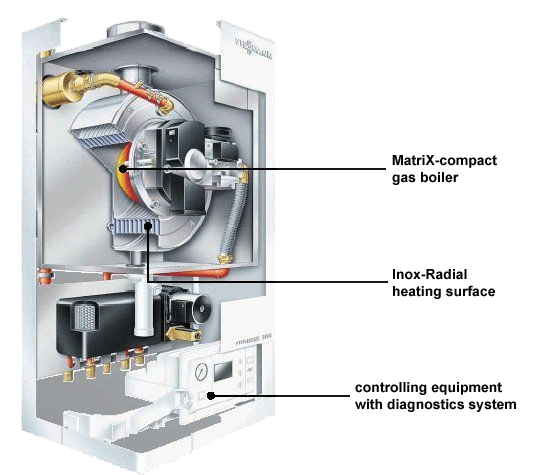 |
| Figure 2: Gas calorific-value boiler as wall heating unit. Dimensions: 0.4m·0.5m·0.9m [http://www.viessmann.de]. |
Heat pump
Heat pumps utilise the thermal energy of the environment with the usage of electricity. For that purpose the energy is extracted from the ground water, the soil or the outside air. The heat absorption and the heat transport is provided by a medium which is moving in a closed circuit and changing one after the other into different conditions. Here the medium is evaporated, condensed, fluidised and relaxed. The heat pump transforms heat from low temperature (e.g. 7°C) into heat at high temperature (e.g. 40°C). Only a third to a quarter of the thermal energy delivered by the heat pump has to be supplied by electricity. The rest (three quarters to two third) comes from the environment. When installing the system it has to be taken care, that systems with low supply temperatures are used (e.g. under floor heating).
Today, electric heat pumps are very common. With their coefficient of performance (COP) from 3 to 4 (that means to receive for 1 kWh electricity 3 kWh to 4 kWh thermal energy) they can much better compensate for the poor primary energy efficiency factor in the generation of electricity. So they are much better regarding the CO2 balance and at least not worse compared to fuel or gas heating. Heat pumps working with gas or fuel seem to be potentially favourable but they are still in experimental stage because of the high maintenance.
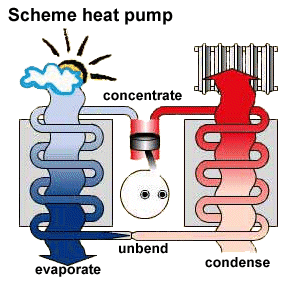 |
| Figure 3: Scheme of the heat pump principle [http://www.waermepumpe-bwp.de]. |
Block power plants
High maintenance is also a reason why small block power plants are rarely installed in residential areas. These systems produce electricity and use the incidental heat energy for heating purposes. In this way the high efficiency of power stations with additional district heat supply is obtained. About 30 % of the energy is transformed into electricity, the rest of 70 % is used as heating energy. There are new organisation or operation models offered, where the units are installed in the buildings but the building owners are not the owners of the units, and, therefore, not responsible for maintenance and repair.
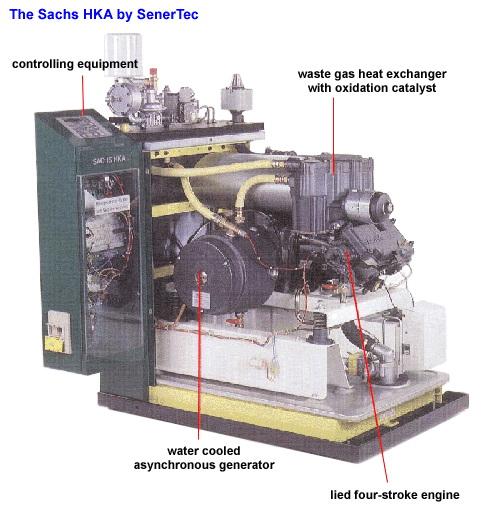 |
| Figure 4: Small power plant with 5 kW electrical and 10 kW thermal output. Dimensions: 1.1m·0.7m·1.0m [http://www.senertec.de]. |
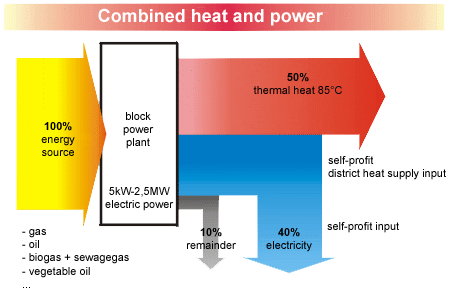 |
| Figure 5: Combined heat and power [http://gbunet.de]. |
Wood pellets or wood chips
Modern wood pellets or wood chips ovens are widely maintenance-free and provide themselves with the help of transporting snails or conveyor belts with the required fuel, which is produced from wood.
 |
|
Figure 6: Wood chips heating, power 7-35 kW. Dimensions of the boiler:0.7m·0.6m·1,4m [http://www.rennergy.de] |
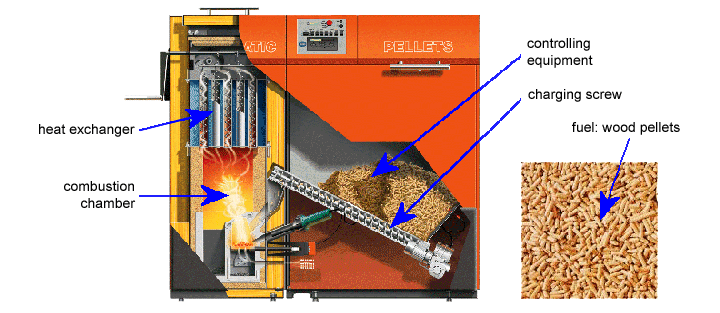 |
| Figure 7: Wood pellet heating with integrated fuel (for about 1 week). Dimensions: 1.6m·0.8m·1.5m [http://www.biopellets.de/Produkte/Pelletheizungen/Biostar/biostar.html]. |
Bio gas
So far, bio gas systems are implemented in relatively huge installations and are only suited for rural areas because of the source of energy. The expenditure of human labour for these systems is comparatively high.
Solar support of the heating system
Solar support of the heating system is very easily incorporated into the central hot water heating. A hot water storage which should be run with a temperature stratification is necessary in addition to the existing boiler. The storage is supplied by the conventional boiler if the solar system does not deliver sufficient heat. The storage can provide its heat either to the heating circuit or to the domestic hot water. In Middle-Europe not enough solar radiation is available during the core time of the heating period (November to February) to be sufficient for room heating . This is different for the supply of domestic hot water, which is needed throughout the whole year, and can be met by the available radiation during summer.
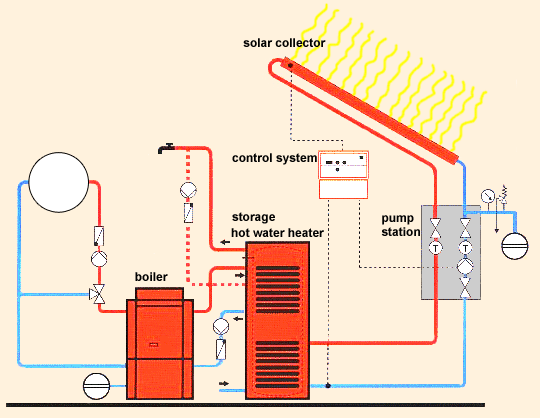 |
| Figure 8: Solar system with heat supply [http://www.mair-haustechnik.de]. |
Fuel cell
The presently (2002) developed fuel cells provide (like small power plants) also electricity besides thermal energy. About 50 % of the employed energy is transformed into electricity, the other 50 % into heat. Because the cells do not contain flexible parts they are nearly maintenance-free. So they are suited for a decentralised combined heat and power supply. The chemical reactions in the fuel cells run at very low temperatures so that the pollution is low (no NOX). Gas, and in future hydrogen, are possible fuels.
Ventilation system with heat recovery
In houses, developed according to the passive house standard, the requirement of heat is so low that there is no need for a conventional heating system. Here the supply air in the already installed ventilation system with heat recovery is heated with the help of gas or electric heating. This is sufficient to cover the demand of the thermal output and the calorific value.
Literature / Links
[1] E.R. Schramek, "Taschenbuch für Heizung + Klimatechnik", R. Oldenbourg-Verlag, München, ISBN 3-486-26214-9, 68. Auflage, 1997.
[2] RWE Energie AG, "RWE-Bauhandbuch", Energie-Verlag-GmbH, Heidelberg, ISBN 3-87200-700-9, 12. Ausgabe, 1998.
[3] "Bauen und Wohnen" - Statistisches Bundesamt Deutschland, http://www.destatis.de/.